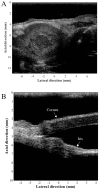Recent Advancements in High-Frequency Ultrasound Applications from Imaging to Microbeam Stimulation
- PMID: 39409511
- PMCID: PMC11479296
- DOI: 10.3390/s24196471
Recent Advancements in High-Frequency Ultrasound Applications from Imaging to Microbeam Stimulation
Abstract
Ultrasound is a versatile and well-established technique using sound waves with frequencies higher than the upper limit of human hearing. Typically, therapeutic and diagnosis ultrasound operate in the frequency range of 500 kHz to 15 MHz with greater depth of penetration into the body. However, to achieve improved spatial resolution, high-frequency ultrasound (>15 MHz) was recently introduced and has shown promise in various fields such as high-resolution imaging for the morphological features of the eye and skin as well as small animal imaging for drug and gene therapy. In addition, high-frequency ultrasound microbeam stimulation has been demonstrated to manipulate single cells or microparticles for the elucidation of physical and functional characteristics of cells with minimal effect on normal cell physiology and activity. Furthermore, integrating machine learning with high-frequency ultrasound enhances diagnostics, including cell classification, cell deformability estimation, and the diagnosis of diabetes and dysnatremia using convolutional neural networks (CNNs). In this paper, current efforts in the use of high-frequency ultrasound from imaging to stimulation as well as the integration of deep learning are reviewed, and potential biomedical and cellular applications are discussed.
Keywords: high-frequency ultrasound imaging; high-frequency ultrasound microbeam; machine learning with high-frequency ultrasonic signals.
Conflict of interest statement
The authors declare no conflicts of interest.
Figures




Similar articles
-
Ultrasonic Assessment of Liver Fibrosis Using One-Dimensional Convolutional Neural Networks Based on Frequency Spectra of Radiofrequency Signals with Deep Learning Segmentation of Liver Regions in B-Mode Images: A Feasibility Study.Sensors (Basel). 2024 Aug 26;24(17):5513. doi: 10.3390/s24175513. Sensors (Basel). 2024. PMID: 39275424 Free PMC article.
-
High frequency ultrasound: a new frontier for ultrasound.Annu Int Conf IEEE Eng Med Biol Soc. 2009;2009:1953-5. doi: 10.1109/IEMBS.2009.5333463. Annu Int Conf IEEE Eng Med Biol Soc. 2009. PMID: 19964020
-
Very Low Frequency Radial Modulation for Deep Penetration Contrast-Enhanced Ultrasound Imaging.Ultrasound Med Biol. 2022 Mar;48(3):530-545. doi: 10.1016/j.ultrasmedbio.2021.11.010. Epub 2021 Dec 28. Ultrasound Med Biol. 2022. PMID: 34972572
-
Ultra-High Frequency Ultrasound, A Promising Diagnostic Technique: Review of the Literature and Single-Center Experience.Can Assoc Radiol J. 2021 Aug;72(3):418-431. doi: 10.1177/0846537120940684. Epub 2020 Jul 28. Can Assoc Radiol J. 2021. PMID: 32721173 Review.
-
High-Frequency and Ultra-High Frequency Ultrasound: Musculoskeletal Imaging up to 70 MHz.Semin Musculoskelet Radiol. 2020 Apr;24(2):125-134. doi: 10.1055/s-0039-3401042. Epub 2020 May 21. Semin Musculoskelet Radiol. 2020. PMID: 32438439 Review.
Cited by
-
Potential of ultrasound stimulation and sonogenetics in vision restoration: a narrative review.Neural Regen Res. 2025 Dec 1;20(12):3501-3516. doi: 10.4103/NRR.NRR-D-24-00841. Epub 2024 Dec 16. Neural Regen Res. 2025. PMID: 39688549 Free PMC article.
References
-
- Shung K.K. Diagnostic Ultrasound: Imaging and Blood Flow Measurements. CRC Press; Boca Raton, FL, USA: 2006.
-
- Lockwood G.R., Turnbull D.H., Christopher D.A., Foster F.S. Beyond 30 MHz: Applications of high frequency ultrasonic imaging. IEEE Eng. Med. Biol. 1996;15:60–71. doi: 10.1109/51.544513. - DOI
-
- Passman C., Ermert H. A 100 MHz ultrasound imaging system for dermatologic and ophthalmologic diagnostics. IEEE Trans. Ultrason. Ferroelect. Freq. Control. 1996;43:545–552. doi: 10.1109/58.503714. - DOI
Publication types
MeSH terms
LinkOut - more resources
Full Text Sources

